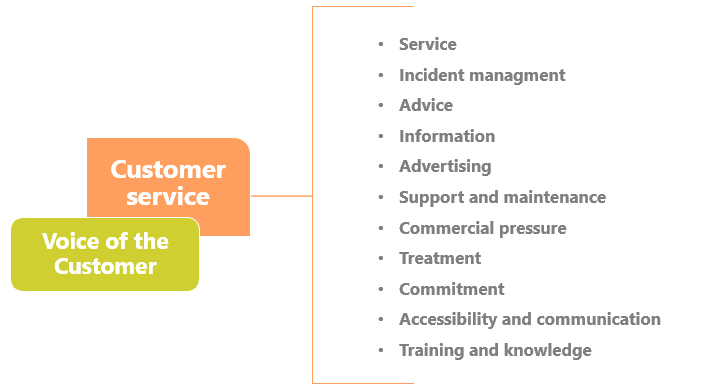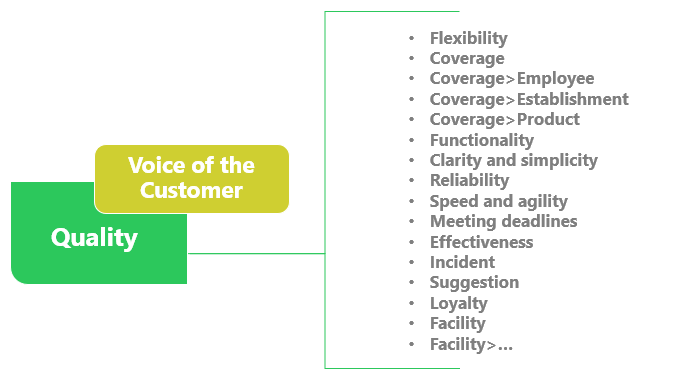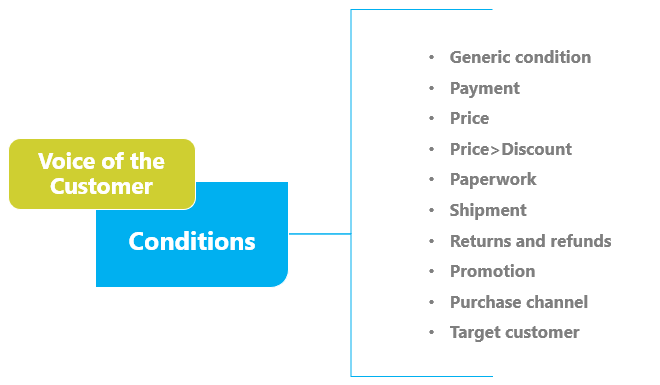
“Your most unhappy customers are your greatest source of learning.” Bill Gates
In a widely digitalized market, open to all and undoubtedly more accelerated than just a decade ago, quickly identifying customer complaints and needs is key to preserve a company’s competitiveness within its industry. Technological democratization has provided users with skills and tools that not only turn the product but also many other aspects into an experience. If after several years of investment and development, your product has come to position itself among the best in the market, does it make sense for a poorly designed purchasing process to threaten the conviction of potential customers that you are worth choosing?
There are many reasons why a bad corporate decision can affect customer experience but listening to the voice of our customers – using the right tools and asking the right questions – can significantly reduce them. A study conducted in the U.S. by Chris Denove and James D. Power IV on customer satisfaction – entitled Satisfaction: How Every Great Company Listens to the Voice of the Customer – demonstrates a direct correlation between customer experience and business success:
“The relationship between satisfaction and shareholder value wasn’t just visible; it was paramount! We divided each company into one of three groups: (1) companies whose customer satisfaction rank within their industry remained constant, (2) those whose rank improved, and (3) those whose satisfaction ranking dropped. The companies that improved customer satisfaction increased their shareholder value by more than 50 percent! And those whose rank declined actually lost 28 percent of their value.”
This extract tells us that a customer’s opinion about a company (in essence, their satisfaction or dissatisfaction with it) has the potential to determine the company’s performance in the stock market. This can’t fall on deaf ears! So, how can we go about approaching the matter the right way? Let’s start from the beginning. The term Voice of the Customer encompasses various market research practices aimed at detecting the expectations, preferences, and concerns of a customer (both current and potential). Nowadays, the amount of data we can gather about our respective brands is overwhelming. On the one hand, we have traditional communication channels, such as online forms or surveys with closed questions, and on the other, primary information sources such as calls to customer service departments (customer-agent telephone interactions in call centers) or comments posted through social media platforms (social networks, shared content platforms, forums, chats, etc.). Our audience expresses itself through different means of communication, for multiple reasons, using different languages and, more and more frequently, in an unsolicited way.
As a result, it is unlikely that this vast amount of data will be collated in an orderly manner, so the sizable challenge of Voice of the Customer analysis is to be able to “structure” this mass of unstructured information and turn it into “actionable conclusions” (implementation of business decisions based on real data). In other words, analytical tools must be flexible and reliable enough so that the heterogeneity of the information collected will not prevent us from taking advantage of all the value that is undoubtedly enclosed. MeaningCloud tools are perfectly capable of categorizing essential information, regardless of its typology, and facilitate the monitoring and generation of performance reports.
We could compare a consumer’s relationship with a product to a journey, due to the need for preparation, a developmental stage and the ability to be rated according to fulfilment. The stops on this customer journey are milestones they must overcome to convince themselves that the company or product they are choosing is the best option. But, as with any trip, unforeseen events can arise, even some that may make you consider cancelling the plan. It is precisely on those occasions when a functional analysis of the Voice of the Client within a social media platform, for example, can neutralize the negative input so that our traveler arrives convinced at their intended destination. Once their suitcases are aboard, we will continue listening to their voice to make sure that their stay is pleasant, preventing them from leaving and, if they do so, that their intention is to return. If we ensure consumer satisfaction, we ensure our own reputation.
“If we ensure consumer satisfaction, we ensure our own reputation.”
Each customer journey is unique (it has its own characteristics), but it takes place in a scenario with common elements:
- Through a channel, through which they get to know the product/service or are directly in contact with it (website, telephone, store, etc.).
- A support service that can address their information or advice needs (request for information or help, incident management, suggestions for improvement, etc.).
- Expectations about the quality of the product or the infrastructure that surrounds it (depending on brand advertising, personal experience or the voice of other users).
- Conditions implicit in the purchase process (prices, warranties, limitations, etc.).
- Comparison with the service provided by competitors.
- A sense of satisfaction or dissatisfaction (would the customer repeat their experience with you?).
At MeaningCloud we have collected all these aspects in a generic Voice of Customer analysis model.

Our model consists of 5 modules or dimensions (information blocks), which in turn include a detailed list of categories (or subtopics). By combining text mining technology, semantic and sentiment analysis, MeaningCloud can extract elements of meaningful information from interactions between the customer and the company through any channel and in any expressive manner (guided or spontaneous). Conversations via e-mail, telephone, social media, and many more channels are precious knowledge for companies, if they are processed intelligently.
To do this, it is necessary to automate analysis tasks to exploit large amounts of data as quickly as possible and in turn, get a real, immediate, 360-degree view of your business. This panorama will help you to continuously improve your business, paying attention to the most significant elements of information. At MeaningCloud we have identified what key aspects we need to motorize in order to convert the mass of unstructured information coming from our clients into a valuable organized database (exploitable by collecting statistics or correlating categories), which would serve as support when refining any business process.
For instance, after a discount campaign promoted by a supermarket chain, several customers might express their dissatisfaction in surveys making these categories to appear:
Condition>Promotion + Quality>Coverage>Product + Satisfaction>Negative
Down below we show some of these comments:
| Intervention’s number | Comment |
|---|---|
| [ITEM 385] | if products appear in the offer brochures, I expect to find them in the store as well |
| [ITEM 398] | More accurate pricing and actual availability of discounted products |
| [ITEM 465] | I rarely find their advertised bargain products. |
| [ITEM 489] | Many times there is no stock of bargain products, not even on the same day that the promotional period begins. |
| [ITEM 511] | They should have in stock the discounted products featured in the brochures, when I go for one of them, they’re usually unavailable to buy. |
| [ITEM 589] | Especially after the weekend there are quite a lot of special price products that can’t be found in the store. |
| [ITEM 702] | SOMETIMES THE PROMOTIONAL PRODUCTS ADVERTISED IN THEIR BROCHURES ARE MISSING |
| [ITEM 834] | Can somebody tell me if their discounted products are real? |
| [ITEM 916] | They should indicate more clearly where their products can be found in the store, prices should be placed precisely without misleading customers and when offers are launched, more discounted products shoud be available: I really hate not finding them, especially if I go to more than one store (they hype their offers and can’t meet the demand). |
| [ITEM 954] | The quality of fresh produce is not good. I go for offers and they are not always available. |
… CONCLUSION: The supermarket chain must take better care to stock the products on offer so that the campaigns become attractive to customers.

The first step is to identify how customers contact the company. This enables us to discover both the preferred communication channel and the possible difficulties that they may experience while using a specific contact method. If a considerable number of customers complain about the poor service received over the telephone, a code of conduct will have to be set out for the telephone support team. On the other hand, if more negative opinions were to converge about the assistance provided in person, it will be necessary to call into question the skills of the front desk staff.
It is often said that workers are “the voice of the company” and, therefore, it is essential to count on competent professionals who know how to best manage user interactions. After all, an organization’s customer service team is composed of the people who stick up for the company during hard times such as managing incidents. If we handle a complaint correctly, we can convince our customer that, despite having had a bad experience, it is still worthwhile to continue shopping in store or continue with their subscription. In the customer service dimension, we deal with the most critical aspects related to the functions of this type of department.


The Voice of the Customer analysis model is designed with the objective of obtaining valuable information about the entire customer experience, so we have integrated a dimension focused on extracting essential information regarding the level of quality perceived by customers. It allows us to identify both the weaknesses and the strengths of our products and operations as a company and, therefore, facilitates decision making for the consolidation or reorientation of our business strategies. Opinions on the condition of facilities, the availability of products, the adaptability of services, as well as the effectiveness of certain practices or the reliability of processes enable us to determine exactly how the management of our business is perceived; in other words, its identity.
Closely linked to the company’s products or services, the conditions dimension analyzes how the characteristics inherent in the purchase of a product affect the customer experience. Is the customer satisfied with the prices in our catalog? Do they value the possibility of receiving a desired purchase directly to their house? Has a specific discount or promotion caught their attention? In the graphic on the left, we outline the conditions that our generic model contemplates.

*We invite you to follow us so that you can read the articles that we will be publishing on our Voice of the Customer analysis models adapted for the banking, insurance, and retail industry. The conditions module acquires in them more complexity and, therefore, more weight.
For each interaction, the system also uses a satisfaction module (the fifth one) that determines whether the client has explicitly expressed any sign of approval or dissatisfaction throughout their experience. Obviously, a customer-company relationship marked by dissatisfaction will require urgent action to avoid the definitive rupture of such a bond. On the contrary, any indicator of satisfaction can be a valuable asset for consolidating a company’s strengths and defining more effective business strategies.
Why MeaningCloud
“No matter where we look, from home building to health care to hotels, the same relationships between customer satisfaction and profitability ring rule. This leads to an inevitable question: if the link between satisfaction and profitability is so clear, why do so many companies act as if they are indifferent to their consumers’ needs?”, Satisfaction: How Every Great Company Listens to the Voice of the Customer, by Chris Denove and James D. Power IV
Until recently, customers could barely communicate with companies. Today they can use numerous channels to do so, even in a public and committed way; this means that the amount of data to analyze is enormous and is increasing day by day. Despite being aware of its value, listening to the Voice of the Customer is not an easy task and remains an unresolved issue for many companies.
MeaningCloud’s Voice of Customer analysis is a solution that brings together agile and flexible multilingual services: deep categorization technology, sentiment analysis, customization tools to adjust these technologies to any business domain or language variant, and so on. In this way, it is possible to detect the nuances of each industry (specific models) without renouncing the power of the generic model. MeaningCloud’s current offering also features specific Voice of Customer analysis models for the Banking, Insurance and Retail domain; we will talk about their unique features in the next publications. Also, we are working on monitoring opinions in Telecommunications and Hospitality industries. If you are interested in any of these analytic approaches, we encourage you to contact us to tell us how we can help you in the task of listening to the Voice of your Customers: we will be happy to develop the best solution for your business!
You can find more information on MeaningCloud’s analysis of the Voice of the Customer on our website, where you can also try our interactive demos.


